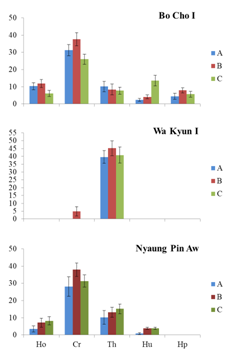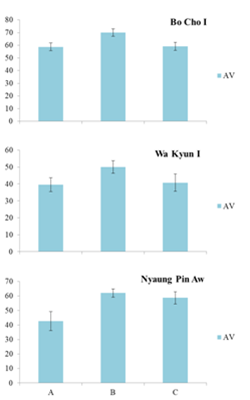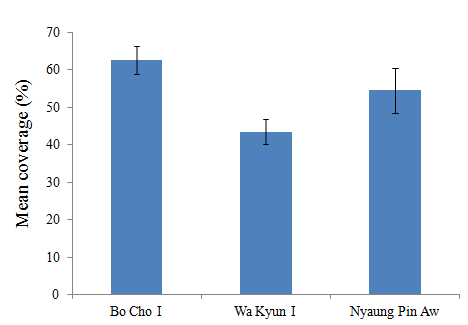Journal of
eISSN: 2378-3184


Research Article Volume 8 Issue 2
1Assistant Lecturer, Department of Marine Science, Myeik University, Myanmar
2Lecturer, Department of Marine Science, Myeik University, Myanmar
3Honours Candidates, Department of Marine Science, Myeik University, Myanmar
4Flinders University of SA, Australia
5Directors, Marine Science Association, Myanmar
Correspondence: Moe Lwin Lwin, Assistant Lecturer, Department of Marine Science, Myeik University, Myanmar
Received: April 03, 2019 | Published: April 16, 2019
Citation: Lwin ML, Htay YY, New NNN, et al. Sea grass surveys in the Eastern part of Lampi Island, in Myanmar. J Aquac Mar Biol. 2019;8(2):47-53. DOI: 10.15406/jamb.2019.08.00242
Sea grass surveys were conducted in Lampi Island (Marine National Park), Taninthayi Region from 7th Novemver to 9th November 2018. A total of 5 species of sea grasses, namely Cymodocea rotundata Ehrenberg et Hemprich ex Ascherson, Halodule uninervis (Forsskal) Ascherson, H. pinifolia (Miki) den Hartog, Thalassia hemprichii (Ehrenberg) Ascherson, Halophila ovalis(R. Brown) Hooker f. were recorded from the survey sites. Thalassia hemprichii represented as a dominant species along the 3 cross-transects in Wa Kyun Island but not the other 2 study sites, Bo Cho Island and Nyaung Pin Aw on which Cymodocea rotudata predominantly occurred. A total of mean coverage of sea grasses were higher in Bo Cho Island (62.64%) than the other 2 study sites, Wa kyun (43.47%) and Nyaung Pin Aw (54.5%). Due to the dominance of the species of Thalassia hemprichii with thick rhizomes, the biomass of the below ground of the seagrasses in Wa Kyun Island (70.43 gm dry.wt m‾²) was much more higher than those of the other 2 study sites, Bo Cho Island (38.49gm dry.wtm‾²) and Nyaung Pin Aw (59.63gm dry.wtm‾²).
Keywords: Cymodocea rotundata, Thalassia hemprichii, marine organisms, Lampi Island, sea grasses
Sea grasses are marine flowering plants that form an important coastal habitat worldwide. They often occur in vast meadows which provide nurseries, shelter and food for a variety of commercially, recreationally and ecologically important species. Twelve genera and 72 species have been reported worldwide.1,2 There are 16 species from Southeast Asia.3
Sea grasses occur all along three Coastal Regions of Myanmar (Rakhine, Ayeyarwady Delta and the Gulf of Mottama (Martaban), and Tanintharyi). A total of eleven species of sea grasses has been recorded in Myanmar, including Syringodium isoetifolium (Ascherson) Danty, Cymodocea serrulata (R. Brown) Aschersonet Magnus, C. rotundata Ehrenberg et Hemprich ex Ascherson, Halodule uninervis (Forsskal) Ascherson, H. pinifolia (Miki) den Hartog, Enhalus acoroides(Linnaeus f.) Royle, Thalassia hemprichii (Ehrenberg) Ascherson, Halophila beccarii Ascherson, H. decipiens Ostenfeld, H. ovalis (R. Brown) Hooker f. and H. major (Zoll).4‒11 listed Halophila spinulosa (R. Br.) Aschers in Myanmar there are no records for those plants in Myanmar so far.
Sea grasses are known to support many endangered species such as turtles and dugongs.12‒14 Myanmar people are well aware of the importance of sea grasses, calling sea grasses as Leik-Sar-Phat-Myet, meaning the food of marine turtles.6 Myanmar seagrass meadows support five species of marine turtles, all of which are IUCN-listed threatened species; the olive ridley turtle (Lepoidochely olivacea; Vulnerable), loggerhead turtle (Caretta caretta; Vulnerable), green turtle (Chelonia mydas; Endangered), hawksbill turtle (Eretmochelys imbricata; Critically Endangered), and the leatherback turtle (Dermochelys coriacea; Vulnerable).6 In addition, the sea grass meadows along the Rakhine Coastal Region are known to serve as important feeding grounds for the sea cow, Dugong dugon, which is listed as Vulnerable on the IUCN Red list.15,16
The ecological roles of sea grasses are very important. They filter estuarine and coastal waters of nutrients, contaminants and sediments and are closely linked to other communities such as coral reefs and mangroves.17 Moreover, they provide habitats for a wide variety of marine organisms.18,19 The relatively high rate of primary production in sea grasses drives detritus-based food chains which helps to support many of these organisms.20 Recently, monitoring and ecosystem services of sea grasses have been studied by,21‒24 In addition, it is worth noting that there has been little focus on the plants themselves especially in genetic, which are important for conservation and management.
The objectives of this surveys are: 1) to know the diversity of sea grasses, and 2) to investigate the coverage and biomass of sea grasses growing in 3 survey sites located in eastern part of Lampi Island Group coastal areas.
Study sites
Sea grass surveys were conducted in 3 study sites of the eastern part of Lampi Island Group, namely Bo Cho Island (Lat 10.66º, Long 98.26º), Nyaung Pin Aw of Lampi Island (Lat 10. 68º, Long 98. 34º), and Wa Kyun Island (Lat 10.72º, Long 98. 29º) (Figure 1), Boakpyin Township, Taninthayi Region, from 6th to 9th November 2018.

Figure 1 Map showing the survey sites in red circle: 1. Bo Cho Island; 2. Wa Kyun Island; 3. Nyaung Pin Aw.
Taxonomic studies
Fresh and live materials of sea grasses growing in three survey sites of Lampi Island were sampled by uprooting the sea grasses with a small trowel. The collections (Figure 2) were washed, cleaned and preserved in 10% formalin in seawater. Samples of sea grasses were examined mainly on the vegetative characters under a dissecting microscope, and then pressed on herbarium sheets to prepare as voucher specimens for each locality. All specimens were identified using the standard monograph of sea grasses prepared by den Hartog.25,26 This study followed the classification system used by Fortes.27 All voucher specimens were deposited at the Herbarium of the Department of Marine Science, Myeik University, Myanmar.
Ecological studies
This study has followed the Sargasso et protocol by Short et al.,28,29 consisting of three fixed, parallel, 50m cross-transects referred to as cross-transects A, B and C, with cross-transect A closest to shore and C most seaward; B, midpoint of these cross-transects were established laid out seaward, perpendicular to the shore. Percentage of sea grasses was visually estimated within 12 randomly place quadrats (50cmx50cm, 0.25m2) along each cross-transect using a photo guide of percent cover (Figure 3). PVC plastic pipe (7.5cm in diameter) was used for coring the sea grass samples. Nine core samples (0m, 25m and 50m of each transect, A, B, and C) of sea grasses were collected (Figure 4) and prepared for biomass of sea grasses in dry weight per m2. Sea grass samples were cut into 2 parts as below ground including sheaths, rhizomes and roots of non-photosythetic parts and above ground, green- colored leaf-blade of photosythetic parts.
The species of sea grasses occurred in the study sites of the eastern part of the Lampi Island Group could be identified (Figure 5 to Figure 9) in the following key characters:
Species of sea grasses found in each study site were described along with the coverage of each study site in Table 1. A total of all five species of sea grasses were encountered in Bo Cho Is. and Nyaung Pin Aw whereas a total of three species except for Halodule uninervis and H. pinifolia were found in Wakyun Is.
Soe Htun et al.30 described the percentage cover of sea grasses in Bochco Island with 20.89% in March whereas this survey revealed those of Bochco Island with 62.64% (Table 1) in November. For this reason, monthly surveys were needed to assess the sustainibility of sea grasses in nature.
The coverage of species of sea grasses along the 3cross-transects in three study sites of the eastern part of the Lampi Island were shown in Figure 10. Thalassia hemprichii represented as a dominant species along the 3 cross-transects in Wa Kyun Island but not the other 2study sites, Bo Cho Island and Nyaung Pin Aw. However, Cymodocea rotudata predominantly occurred those 2study sites, except for Wa Kyun Island.

Figure 10 Coverage of species of seagrasses along the cross-transects in three study sites of the eastern part of the Lampi Island.
Comparison of mean coverage of sea grasses of the 3cross-transects in three study sites of the eastern part of the Lampi Island were shown in Figure 11 & Figure 12. In all study sites, the coverage of sea grasses of the middle cross-transect B were remarkably higher than cross-transects A and C. A total of mean coverage of sea grasses were higher in Bo Cho Island (62.64%) than the other 2 study sites, Wa Kyun (43.47%) and Nyaung Pin Aw (54.5%). Likewise, comparison of mean biomass of sea grasses of the 3 cross-transects in three study sites of the eastern part of the Lampi Island were shown in Figure 13 & Figure 14. Due to the dominance of the species of Thalassia hemprichii with thick rhizomes, the biomass of the below ground of the sea grasses in Wa Kyun Island (70.43gm dry.wt m‾²) was much more higher than those of the other 2 study sites, Bo Cho Island (38.49gmdry. wt m‾²) and Nyaung Pin Aw (59.63gmdry.wt m‾²).

Figure 11 Coverage of seagrasses along the cross-transects in three study sites of the eastern part of the Lampi Island.

Figure 12 Comparison of mean coverage of seagrasses along the cross-transects in three study sites of the eastern part of the Lampi Island.

Figure 13 Biomass of sea grasses along the cross-transects in three study sites of the eastern part of the Lampi Island.

Figure 14 Comparison of biomass of sea grasses in three study sites of the eastern part of the Lampi Island.
The sea grass here is still very pristine and only few researches have been carried out in Myanmar. Thus, capacity building and sea grass monitoring network are very important for this very first few years. Sea grass is well known for its ecosystem service values, they provide home, food and nursery grounds for various marine organisms as well as the important coastal water engineering in the shallow coastal zone. Sea grasses also tie closely with fishermen livelihood; an important ground for small fisheries including crab, sea cucumber, gastropods and others associated faunas.
It is important to note that along this long coastal line and hundreds of islands of Myanmar, there is only one Marine National Park, the Lampi Island. Thus, the understanding of biodiversity and distribution of these marine organisms, sea grass, seaweeds, mangroves and corals, are urgently needed for further management and policy making decision.
The followings are the recommendation and future plans for sea grass conservation and monitoring in Myanmar:
We are indebted to Dr Nyo Tun, Professor, Head of Department of Marine Science, and Rector and Administration Board members of Myeik University for their kind permission to conduct this sea grass surveys in the eastern part of the Lampi island, Marine National Park of Myanmar and U Khin Maung Htwe, living in Makyone Galet Village, Lampi Island for his helpful assistance in field works. In addition, the authors are grateful to all staffs of Department of Marine Science, Myeik University, for their helpful assistance to this survey program and Filippo Maria Carli, Marine Coordinator, Fuana and Flora International (FFI), for sharing his knowledge on ecosystem services of sea grass beds. Many thanks go to Thu Rein and the staffs of the Marine Science Association, Myanmar (MSAM) for their assistance in the preparation of the manuscript. Supports for this work from Fauna & Flora International (FFI) are most appreciated.
We (the authors) declare that there are no conflicts of interest in relation to this article.

©2019 Lwin, et al. This is an open access article distributed under the terms of the, which permits unrestricted use, distribution, and build upon your work non-commercially.